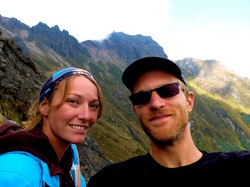
http://www.twobeinchili.com/
The links we have sent you before may not work anymore, sorry for the inconvenience.
 Good afternoon! Just wanted to let you all know that we have made some changes to our website, namely we now have our own domain name!
http://www.twobeinchili.com/ The links we have sent you before may not work anymore, sorry for the inconvenience.
1 Comment
Our time in Baños and Quito has been a blast, but we’ve both been experiencing some serious nature withdrawal – we need to get back into the forest!! Well, if things go as planned, in the next few days we’ll be setting off on a serious adventure deep into the Amazon jungle. This trip could take anywhere from one to three weeks, likely without any internet or phone access – look out for our SPOT GPS updates letting you all know we’re still alive and kicking. =)
Our original plan was to catch a bus from Quito and head further inland, over the mountains and into the area known as “the Orient”. There are a few parks that are supposed to be great, Yasuni National Park among them, and since oil companies have begun to work on extracting the vast reserves found under the park, we figure there may not be much of it left after a few years. Upon reading a bit about getting into the park (quite a feat in itself), however, we found that it’s actually possible (though not always recommended) to continue along the Rio Napo all the way deep into the Peruvian jungle. We’re not exactly sure what this kind of adventure will have in store for us, but that’s part of the fun, right?? After spending the morning doing some research online, it seems the trip will be something like the following:
Quito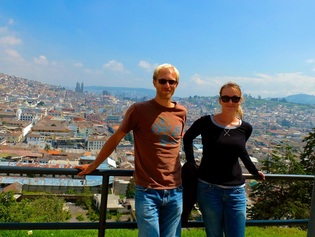 overlooking the old city overlooking the old city We spent the last week or so in and around Quito, the highest city in Ecuador (at 2800 metres above sea level). With a population of about two million it’s a reasonably large city, though the surrounding mountains squeeze it into such a long and narrow shape that it can take hours to travel from one end to another. Despite our general dislike of large cities, we actually enjoyed a couple afternoons wandering around and taking in the sights: epic churches, interesting museums, huge parks, artisanal markets, and interesting architecture - oh, and there’s also a pub with craft beer which is a much needed change from the usual boring Ecuadorian beer. 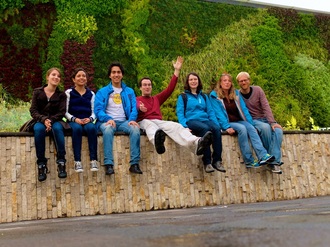 chillin' with some of the IAESTE crowd chillin' with some of the IAESTE crowd One of the main reasons we decided to visit Quito is because a friend of mine, Michael-Anthony (usually just “M.A.”) happened to be here for an IAESTE (International Association for the Exchange of Students for Technical Experience... phew!) conference. M.A. and I have shared some other interesting coincidences in the past – on my first day of work during my IAESTE internship in Vienna in 2007, I walked into the office only to find M.A. (who was also taking Mechanical Engineering at UofT) sitting at the desk beside mine. For whatever reason, we had to travel halfway around the world to become friends, and had soon drank half the beer in Austria and formed an impromptu band with a couple other interns... some great memories. It was nice to spend some time catching up and taking in some of the sights. He also snuck us onto a bus tour and scored us a free lunch, helping us pose as conference attendees. =) 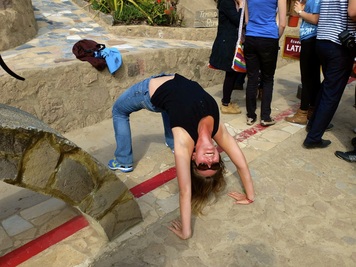 will the Coriolis forces tear her torso apart?? will the Coriolis forces tear her torso apart?? The center of Quito is located about 25 km south of the actual equator, and one of the more interesting stops on the bus tour was at “la mitad del mundo” – a site marking the location (or close enough) of the actual equator. Our tour guide eagerly demonstrated some of the phenomena associated with being on the equator, most of which M.A. and I, being rational engineers, tried to debunk. The one that really irked us was the demonstration of water draining in a sink, with the direction changing due to the Coriolis Effect. The demonstration showed that the same sink drained differently depending on where it was placed: directly on the equator (draining straight down), ten feet north of the equator (draining counter-clockwise), and ten feet south of the equator (draining clockwise). At first we were a bit baffled, but upon looking closer we noticed that the guy leading the show was totally cheating!! Before draining the sink on the equator, the water was left for a few minutes to make sure it was completely still, but right before the demos off of the equator the water was poured from a bucket in such a way as to already get the water moving in the right direction. Poppycock, I say! Once the demo ended, we stepped in and were able to, by pouring from the bucket in the right way, get the water to drain the opposite way it was supposed to. BAH. I’m not disputing the Coriolis Effect, I’m just saying there’s no way it can make a difference over such a small scale… anyways, maybe we were taking things too seriously. Cotopaxi National Park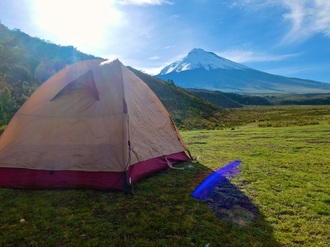 our mountain home our mountain home The other reason we came to Quito is its proximity to Cotopaxi National Park, about fifty kilometres south of Quito and the home of Cotopaxi, Rumiñahui, and Sincholagua volcanoes, with Cotopaxi being among the highest active volcanoes in the world. If you’ve been keeping up with our adventures so far, you’d know that we were way overdue for a volcano hike, though the high elevation made this one a much different experience from La Concepción and Telica (Nicaragua) and Arenal (Costa Rica).
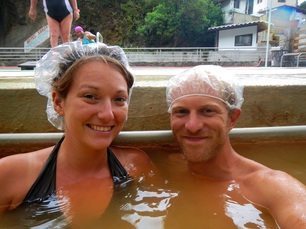 They made us wear the caps They made us wear the caps Aaaaaahhhhhh hot springs…… There is NOTHING better than a day spent soaking in natural hot water with tons of happy strangers. Baños was a perfect contrast from the loud and dirty Montañita. Nestled high in the Andes Mountains at 1815m above sea level, Baños is a small, very green and picturesque volcano village with about 17,000 residents, literally located in the line of lava from the highly active Tungurahua volcano. As recently as 1999 the entire town had to evacuate as a precaution, though luckily the volcano didn’t totally blow. 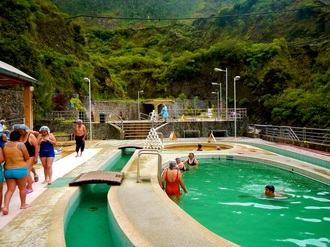 There were many pools of different temperatures There were many pools of different temperatures We spent two nights at a very nice “eco” hotel called La Casa Verde. It was the most expensive place we have stayed so far on our trip at $50 per night, and it was totally worth it! After the Dengue fiasco we decided it was time for a little treat. Not only was the place itself very nice, the people staying there were fun to chat with, they had 100’s of DVD's, and they had amazing organic vegetarian food. I wasn’t completely ready to enjoy full meals at this point but by the time we left I was feeling so much better. On the first day we just wandered around the town and soaked in one of the many hot springs. It was very “tranquillo”. And on the second day we figured we could do some white water rafting since adventure travel is one of the main attractions in Baños. 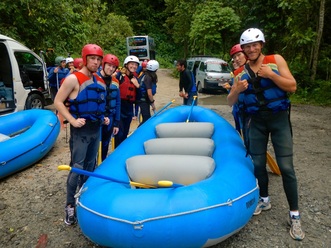 The Titanic team! The Titanic team! Rafting was much more exciting than we had anticipated! We have both been on rivers in multiple countries and for the most part have found white water rafting to be somewhat boring at times between rapids, and exciting only for 5 or 6 quick rapids. Neither of us had flipped a raft before, though we had both fallen out a couple of times in a relatively controlled manner. This trip was different. From the moment we entered the river until we finished the trip an hour or two later it was non-stop action! And not just tame rapids either, but very strong currents and large boulders that we had to ram every time even though half of the people in our raft were terrified. They were terrified for good reason too, perhaps!
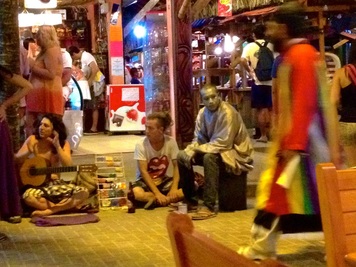 Montañita, Ecuador - lots of interesting people Montañita, Ecuador - lots of interesting people It started out as a very high fever. I thought I was going to freeze to death but the thermometer said I was nearly 104°F. In the middle of the night on day two of the fever we went to the hospital. There were two nurses telling jokes to each other in the corner who were visibly annoyed that we showed up. They woke up the pharmacist who took some blood, told us that I didn’t have dengue and sent us home. No investigation into what it would have been. Just told us to go away. Later we found out that you can’t test positive for Dengue until after 6 days of fever. The next day I went to a different pharmacist down the street from our hostel and asked for antibiotics because I thought maybe I had an infection or something. They gave them to me without question or explanation of any side effects or anything. I later found out that you can get as much of anything you want from any pharmacy here – for example a guy from our Spanish classes bought 20 or more vicodin, valium, oxycotin and some other mystery drugs that are apparently stronger than all of those. He bought them all at once and took most of them in one day. Apparently this is one reason that a lot of people come to Montañita. The doctor recommended that I return for monitoring in a few days, however when we did return, no one there could find any record of me ever being there so after A LOT of persuasion we got them to run some new tests that we took with us and emailed to our health insurance providers in Canada. Luckily google gave us the heads up on my symptoms and nothing suggested the dangerous type of dengue (the one where you haemorrhage and your insides turn to mush) so I just had to wait it out. After 12 days of fever between 101-104°F I finally awoke without a fever. For the next three days I had random full body hive flare-ups which google alerted us was normal for the recovery stage of Dengue. It took another few days before I was able to eat a full meal again and about two weeks before the nausea finally left (now). 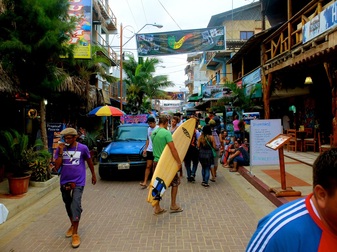 Unfortunately my opinion of Montañita is not too good, likely in part based on the fact that I felt like crap the whole time we were there. However I did manage to attend 20 hours of Spanish lessons at Montañita Spanish School, which were very good, and we did a couple of smaller day excursions as well. I just had to get out of the hostel we were staying in. Recently, while in the mountain town of Boquete, Panama, I had the opportunity to take a tour of a small coffee farm, and thoroughly enjoyed being able to see firsthand how my favourite morning beverage makes it all the way from the seed to my cup. It blew my mind how much work actually goes into producing a cup of coffee, so I thought I’d share with you the “story of coffee”. Enjoy! ~Mandrew Origin of Coffee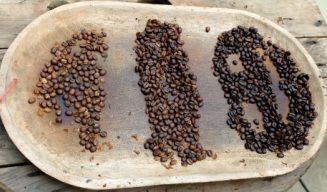 light, medium, and a happy dark roast light, medium, and a happy dark roast With a coffee shop or four on every street corner these days, it’s easy to take it for granted that most days begin only after I’ve had my first cup of java. After having witnessed the tremendous amount of work that goes into producing coffee, however, I’m forced to wonder – who the heck thought to go through all this trouble? Well, it seems there are a few different stories about how coffee was discovered, and although this one seems the least credible, I find it the most entertaining:
Sometime in the ninth century A.D., an Ethiopian goat-herder named Kaldi noticed that, after eating a certain plant, his goats behaved quite strangely, running and jumping around all nimbly-bimbly. Thinking that he’d be able to get the same kind of energy boost (or maybe just wanting to get high), Kaldi decided to try it for himself. First, he tried munching on some of the berries, but found that they were too bitter. He then tried chewing on some of the leaves, but quickly found them to be too tough and waxy to continue. Next, he got the bright idea of brewing a tea from the leaves, but alas that, too, tasted like crap. In a fit of hopeless rage, Kaldi tore up the plants and cast them into his fire. A few minutes later, however, he noticed that the burnt plants smelled damn good, and after some investigating found that it was the roasted berries that were releasing the fantastic aroma. He ground up some of these roasted berries and steeped them in hot water, and instantly became the happiest man in Ethiopia. 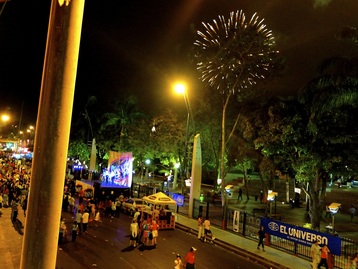 I can’t blame any of you for not knowing the proper way to celebrate New Year’s Eve, because until just a few days ago we too were in the dark. But, now having lived through the festivities in Guayaquil, Ecuador’s biggest city, we feel we must share with you what is clearly the correct way to go about it. Follow these five simple steps, and we're sure you, too, will agree. ¡Prospero Año! Mandrew & Chelsea Step One: Prepare As one would imagine, a reasonable amount of work needs to go into getting ready for a serious celebration like this. On this front, I’m sure we’re all aware of the obvious: stock up on liquor, invite friends over, buy some snacks, etc. What I will focus on, however, are the things that will transform the event from something like an afternoon tea with your grandmother to, well, something like an Ecuadorian-style New Year’s Eve celebration. You will need to procure the following:
Step Two: Eat, Drink, and be Merry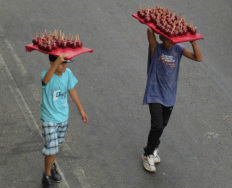 Alright, you’ve got everything ready nice and early, why not get out and enjoy the afternoon before the serious stuff starts? Remember to bring along some dinero so you can buy treats from the many street vendors. Popular choices are beer or sangria, and if you’re thinking, “but it’s too early to start drinking!” then I recommend you keep your thoughts to yourself. 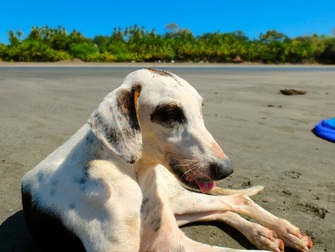 Shnoopy - one of the sick dogs in Santa Catalina Shnoopy - one of the sick dogs in Santa Catalina Hola Amigos,
After a few months of travelling in Central America, I want to share with you some of the things that we didn't like. While we have found much beauty and met several wonderful people along the way, not everything is wonderful all of the time. I can't speak accurately for Andrew though I know that he is having a little difficulty dealing with not having a "goal" or "mission" to work toward. For me it is a little bit different. I don't miss "home" exactly, but the constantly packing and unpacking is a little bit tiring, and I am getting sick of my clothes. Always the same outfits that I don't really like anymore, lol, and always having to decide which outfit is less dirty to wear that day. It feels like we are constantly doing laundry! This doesn't bother me THAT much, but along with a few other things, makes some days feel very exhausting. What has been getting to me more lately are the negative looks from people in places that we go. It is not the majority of people by any means, but those few and far between people who clearly do not appreciate our presence in their town and who believe that we are somehow the cause of all of their pain and suffering. I try not to let it get to me, but I have to admit that it does make me feel guilty. Guilty that I have enough money that I can go travelling for a year and not have to worry about starving to death on any given day. Guilty that if I don't like it here, I can just go somewhere else. This combined with the majority of people who are constantly trying to overcharge us because they believe that we are some sort of money machine and don't actually care at all to know who we are. Often times they go out of their way to make sure that we feel guilty if we don't buy something from them. It really is unfair that we can live our lives this way, and most people in the world will never have this opportunity. It is shameful that corruption, greed and politics get in the way of government and allow this to go on in this day and age. 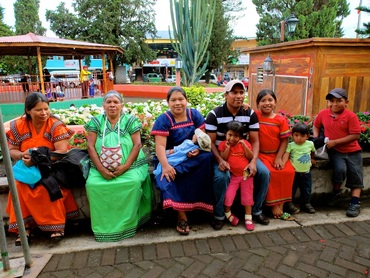 Traditionally dressed indigenous family in Boquete Traditionally dressed indigenous family in Boquete Prospero Año Nuevo! We hope you have celebrated as hard as we have (though I doubt it is possible!). We are in Ecuador now but we have a chance to catch up on posting photos so we figured that we would just post all of our Panama stuff in one update. Panama was an interesting and nice place from what we saw. We spent almost a month in the country including a stop in Boquete, a northern mountain town, Santa Catalina, a surfing town and hub to the Coiba Island National Park, and Panama City, the home of the infamous Pacific/Atlantic Panama canal. All in all it was a good time, but I do have to admit that something has changed in our travelling mindset at this point and I believe I that my view of Panama may be slightly influenced by travellers' fatigue/ travellers' blues (if there is such a thing). More on this later, but for now, here's PANAMA! - Chelsea Boquete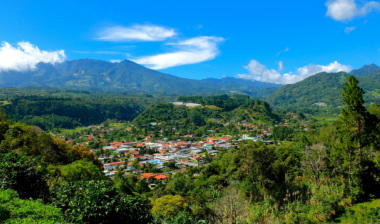 looking down at Boquete looking down at Boquete Ignoring the missed bus stop and the couple useless days in Santiago, our first real week in Panama was spent in Boquete, a neat town nestled in the mountains and surrounded by coffee plantations and rainforest. Named “the best spot to retire” by some American geezer publication, about half of the people there seemed to be either retirees, backpackers, or huge families of Guaymí (one of the many tribes of indigenous Panamanians) who come to find work harvesting coffee. Although it’s a great town to explore by foot or leave for various interesting day-trips (hot springs, mountain biking, etc.), we spent the majority of our time recovering from the past couple weeks, hunkering down in our hostel or visiting the nearby gelato shop. 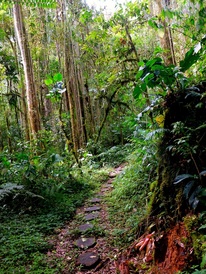 part of the Quetzal Trail part of the Quetzal Trail As we’ve found with many other places in Central America, Boquete and the surrounding area attract a lot of attention from bird watchers. We spent a day hiking part of the Quetzal Trail, in the hopes of catching a glimpse of the resplendent quetzal, a pretty badass bird that nests in the area. Unfortunately, we came up short and didn’t spot much more than a squirrel, although the hike was still quite nice.
|